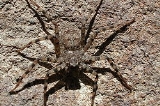
Wall crab spider
Encyclopedia
The wall crab spiders a member of a group of families collectively called crab spider
s because of their laterigrade (sideways-moving) legs. This family consists of about 175 species in four genera, of which Selenops is the best known. The family is primarily tropical with the genus Anyphops confined to Sub-Saharan Africa and the genus Hovops confined to Madagascar
. The spiders are very flat and are commonly found on walls or under rocks. They are quite agile and very difficult to capture. In addition their coloring makes them often quite difficult to see. Like almost all Entelegynae
, they have eight eyes. At least one species of Garcorops, G. jadis
is known only from subfossil copal.
Crab spider
Crab spider is a common name applied loosely to many species of spiders, but most nearly consistently to members of the family Thomisidae...
s because of their laterigrade (sideways-moving) legs. This family consists of about 175 species in four genera, of which Selenops is the best known. The family is primarily tropical with the genus Anyphops confined to Sub-Saharan Africa and the genus Hovops confined to Madagascar
Madagascar
The Republic of Madagascar is an island country located in the Indian Ocean off the southeastern coast of Africa...
. The spiders are very flat and are commonly found on walls or under rocks. They are quite agile and very difficult to capture. In addition their coloring makes them often quite difficult to see. Like almost all Entelegynae
Entelegynae
The Entelegynae are a subgroup of araneomorph spiders. Almost all members of this group, unlike most members of Haplogynae, have eight eyes, and females have a genital plate....
, they have eight eyes. At least one species of Garcorops, G. jadis
Garcorops jadis
Garcorops jadis is a possibly extinct species of Wall crab spider, family Selenopidae, and at present, it is one of four known species in the genus Garcorops. The species is solely known from copal found on the beach near Sambava, on the northeast coast of Madagascar.-History and...
is known only from subfossil copal.
Genera
- Anyphops (Africa, Madagascar)
- Garcorops (Madagascar, Comoro Islands)
- Hovops (Madagascar, Reunion)
- SelenopsSelenopsSelenops is a spider genus that is found in many deserts of the world. It is very hard to distinguish the 115 species.S. australiensis is found on or under dry bark in Australia. The female reaches 9mm, the male 7mm. It looks superficially like a huntsman spider.S...
(America, Asia, Africa, Mediterranean)

